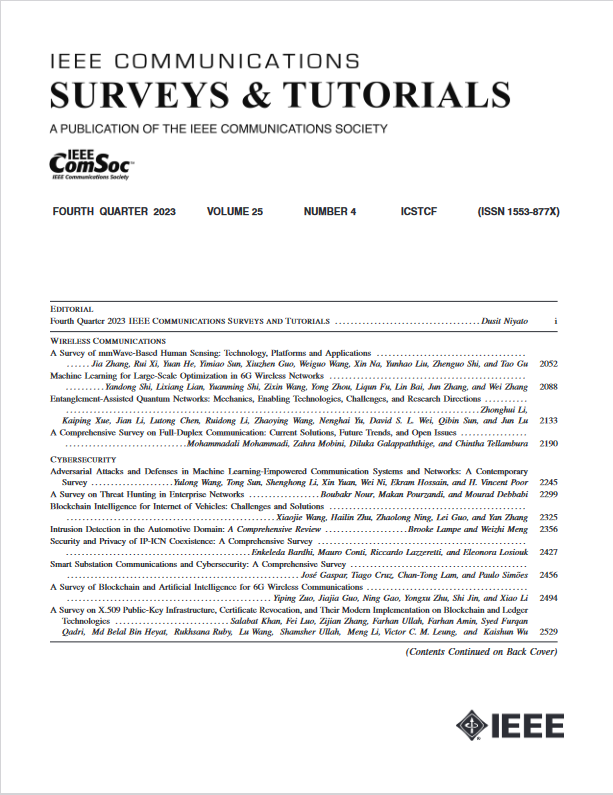支持6g的物联网边缘学习:漏洞、数据集和防御的全面调查
IF 34.4
1区 计算机科学
Q1 COMPUTER SCIENCE, INFORMATION SYSTEMS
引用次数: 0
摘要
在万物互联(IoE)应用和未来网络(例如第六代(6G)网络)中部署第五代(5G)无线网络带来了许多运营挑战和限制,例如在安全和隐私方面。边缘学习是一种新兴的方法,可以跨分布式客户端训练模型,同时确保数据隐私。当这种方法集成到未来的网络基础设施(例如6G)中时,可以潜在地解决资源管理和行为预测等具有挑战性的问题。然而,已知边缘学习(包括分布式深度学习)容易受到篡改和操纵。本文对现有文献进行了全面回顾,重点关注支持6g的物联网(IoT)系统的边缘学习相关漏洞和防御。现有的用于6G-IoT安全和机器学习相关威胁的机器学习方法主要基于学习模式进行分类,即集中式、联合式和分布式。然后,我们概述了使能6G-IoT智能的新兴技术。我们还对针对机器学习的攻击的现有研究进行了全面调查,并将威胁模型分为八类,即:后门攻击,对抗性示例,组合攻击,中毒攻击,Sybil攻击,拜占庭攻击,推理攻击和丢弃攻击。此外,我们还提供了针对边缘学习相关漏洞的最先进防御方法的全面详细分类和比较摘要。最后,随着新的攻击和防御技术的实现,讨论了支持6g的物联网的新研究和未来整体前景。本文章由计算机程序翻译,如有差异,请以英文原文为准。
Edge Learning for 6G-Enabled Internet of Things: A Comprehensive Survey of Vulnerabilities, Datasets, and Defenses
The deployment of the fifth-generation (5G) wireless networks in Internet of Everything (IoE) applications and future networks (e.g., sixth-generation (6G) networks) has raised a number of operational challenges and limitations, for example in terms of security and privacy. Edge learning is an emerging approach to training models across distributed clients while ensuring data privacy. Such an approach when integrated in future network infrastructures (e.g., 6G) can potentially solve challenging problems such as resource management and behavior prediction. However, edge learning (including distributed deep learning) are known to be susceptible to tampering and manipulation. This survey article provides a holistic review of the extant literature focusing on edge learning-related vulnerabilities and defenses for 6G-enabled Internet of Things (IoT) systems. Existing machine learning approaches for 6G–IoT security and machine learning-associated threats are broadly categorized based on learning modes, namely: centralized, federated, and distributed. Then, we provide an overview of enabling emerging technologies for 6G–IoT intelligence. We also provide a holistic survey of existing research on attacks against machine learning and classify threat models into eight categories, namely: backdoor attacks, adversarial examples, combined attacks, poisoning attacks, Sybil attacks, byzantine attacks, inference attacks, and dropping attacks. In addition, we provide a comprehensive and detailed taxonomy and a comparative summary of the state-of-the-art defense methods against edge learning-related vulnerabilities. Finally, as new attacks and defense technologies are realized, new research and future overall prospects for 6G-enabled IoT are discussed.
求助全文
通过发布文献求助,成功后即可免费获取论文全文。
去求助
来源期刊

IEEE Communications Surveys and Tutorials
COMPUTER SCIENCE, INFORMATION SYSTEMS-TELECOMMUNICATIONS
CiteScore
80.20
自引率
2.50%
发文量
84
审稿时长
6 months
期刊介绍:
IEEE Communications Surveys & Tutorials is an online journal published by the IEEE Communications Society for tutorials and surveys covering all aspects of the communications field. Telecommunications technology is progressing at a rapid pace, and the IEEE Communications Society is committed to providing researchers and other professionals the information and tools to stay abreast. IEEE Communications Surveys and Tutorials focuses on integrating and adding understanding to the existing literature on communications, putting results in context. Whether searching for in-depth information about a familiar area or an introduction into a new area, IEEE Communications Surveys & Tutorials aims to be the premier source of peer-reviewed, comprehensive tutorials and surveys, and pointers to further sources. IEEE Communications Surveys & Tutorials publishes only articles exclusively written for IEEE Communications Surveys & Tutorials and go through a rigorous review process before their publication in the quarterly issues.
A tutorial article in the IEEE Communications Surveys & Tutorials should be designed to help the reader to become familiar with and learn something specific about a chosen topic. In contrast, the term survey, as applied here, is defined to mean a survey of the literature. A survey article in IEEE Communications Surveys & Tutorials should provide a comprehensive review of developments in a selected area, covering its development from its inception to its current state and beyond, and illustrating its development through liberal citations from the literature. Both tutorials and surveys should be tutorial in nature and should be written in a style comprehensible to readers outside the specialty of the article.
 求助内容:
求助内容: 应助结果提醒方式:
应助结果提醒方式:


